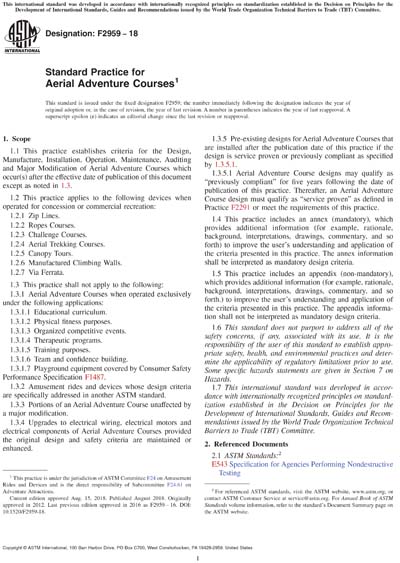Historical
ASTM F2959-18
Standard Practice for Aerial Adventure Courses
1.1 This practice establishes criteria for the Design, Manufacture, Installation, Operation, Maintenance, Auditing and Major Modification of Aerial Adventure Courses which occur(s) after the effective date of publication of this document except as noted in 1.3.
1.2 This practice applies to the following devices when operated for concession or commercial recreation:
1.2.1 Zip Lines.
1.2.2 Ropes Courses.
1.2.3 Challenge Courses.
1.2.4 Aerial Trekking Courses.
1.2.5 Canopy Tours.
1.2.6 Manufactured Climbing Walls.
1.2.7 Via Ferrata.
1.3 This practice shall not apply to the following:
1.3.1 Aerial Adventure Courses when operated exclusively under the following applications:
1.3.1.1 Educational curriculum.
1.3.1.2 Physical fitness purposes.
1.3.1.3 Organized competitive events.
1.3.1.4 Therapeutic programs.
1.3.1.5 Training purposes.
1.3.1.6 Team and confidence building.
1.3.1.7 Playground equipment covered by Consumer Safety Performance Specification F1487.
1.3.2 Amusement rides and devices whose design criteria are specifically addressed in another ASTM standard.
1.3.3 Portions of an Aerial Adventure Course unaffected by a major modification.
1.3.4 Upgrades to electrical wiring, electrical motors and electrical components of Aerial Adventure Courses provided the original design and safety criteria are maintained or enhanced.
1.3.5 Pre-existing designs for Aerial Adventure Courses that are installed after the publication date of this practice if the design is service proven or previously compliant as specified by 1.3.5.1.
1.3.5.1 Aerial Adventure Course designs may qualify as “previously compliant” for five years following the date of publication of this practice. Thereafter, an Aerial Adventure Course design must qualify as “service proven” as defined in Practice F2291 or meet the requirements of this practice.
1.4 This practice includes an annex (mandatory), which provides additional information (for example, rationale, background, interpretations, drawings, commentary, and so forth) to improve the user’s understanding and application of the criteria presented in this practice. The annex information shall be interpreted as mandatory design criteria.
1.5 This practice includes an appendix (non-mandatory), which provides additional information (for example, rationale, background, interpretations, drawings, commentary, and so forth.) to improve the user’s understanding and application of the criteria presented in this practice. The appendix information shall not be interpreted as mandatory design criteria.
1.6 This standard does not purport to address all of the safety concerns, if any, associated with its use. It is the responsibility of the user of this standard to establish appropriate safety, health, and environmental practices and determine the applicability of regulatory limitations prior to use. Some specific hazards statements are given in Section 7 on Hazards.
1.7 This international standard was developed in accordance with internationally recognized principles on standardization established in the Decision on Principles for the Development of International Standards, Guides and Recommendations issued by the World Trade Organization Technical Barriers to Trade (TBT) Committee.
Content Provider
ASTM International [astm]






